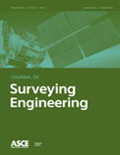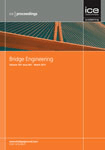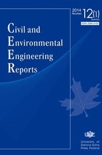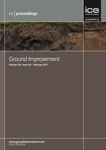
JOURNAL OF SURVEYING ENGINEERING
Scope & Guideline
Transforming Research into Real-World Surveying Solutions
Introduction
Aims and Scopes
- GNSS and Positioning Techniques:
The journal emphasizes research on Global Navigation Satellite Systems (GNSS), exploring new algorithms, positioning methods, and applications in various environments, including urban, underwater, and forested areas. - Geodetic Infrastructure Development:
A core focus on the design and performance evaluation of geodetic networks and Continuous Operating Reference Stations (CORS), addressing challenges in geospatial data collection and infrastructure. - Statistical Modeling and Error Analysis:
Consistent contributions in statistical methods for surveying, including least squares adjustment techniques, precision estimation, and error modeling, to enhance the reliability of geodetic measurements. - Emerging Technologies in Surveying:
Innovative applications of technologies such as UAVs, LiDAR, and photogrammetry are explored, highlighting the integration of these tools in modern surveying practices. - Historical and Theoretical Perspectives:
The journal also delves into historical case studies and theoretical explorations, providing insights into the evolution of surveying practices and their implications on current methodologies.
Trending and Emerging
- Integration of Machine Learning and AI:
There is a growing trend towards the application of machine learning and artificial intelligence in surveying, particularly in data analysis, error detection, and predictive modeling. - Sustainable and Environmental Applications:
Research increasingly focuses on applications related to environmental monitoring and sustainability, such as assessing subsidence and managing natural resources using advanced surveying techniques. - Real-Time and Dynamic Monitoring Systems:
The development of real-time monitoring systems using GNSS and other technologies is gaining traction, emphasizing the need for immediate data processing and analysis in various engineering applications. - Interdisciplinary Approaches:
Emerging themes show an inclination towards interdisciplinary research, combining surveying with fields such as geology, environmental science, and urban planning, to address complex real-world challenges. - Enhanced Accuracy and Precision Methods:
Recent publications are increasingly focused on improving the accuracy and precision of measurements through innovative algorithms and methodologies, reflecting the demand for high-integrity data in modern applications.
Declining or Waning
- Traditional Surveying Methods:
There seems to be a decreasing emphasis on classical surveying techniques, such as trigonometric leveling and manual measurements, as the field increasingly shifts towards automated and technology-driven solutions. - Historical Case Studies:
Although historical analyses were once a significant focus, recent issues show a decline in publications centered around historical surveying practices, indicating a shift towards contemporary and future applications. - Non-GNSS Positioning Techniques:
There has been a notable reduction in research exploring non-GNSS-based positioning methods, as GNSS technologies continue to dominate the field, overshadowing alternative techniques.
Similar Journals

Geodetski Vestnik
Fostering Collaboration in Geodesy and Beyond.Geodetski Vestnik is a prominent open-access journal published by the Association of Surveyors Slovenia, dedicated to advancing the field of Earth and Planetary Sciences. With an ISSN of 0351-0271 and an E-ISSN of 1581-1328, this journal has been contributing valuable research since its inception in 1992, with converged years extending to 2024. As of 2023, it holds a Q3 category in Earth and Planetary Sciences and ranks #144 out of 195 in its Scopus category, indicating a focused, though emerging, presence in the scientific community. The journal embraces a commitment to open access since 2003, ensuring that research is freely accessible to professionals, researchers, and students worldwide. Geodetski Vestnik serves as a vital platform for disseminating innovative research, methodological advancements, and significant case studies in geodesy and related sciences, fostering collaboration and knowledge sharing among scholars and practitioners in Slovenia and beyond.

Proceedings of the Institution of Civil Engineers-Bridge Engineering
Bridging Theory and Practice in Civil EngineeringProceedings of the Institution of Civil Engineers - Bridge Engineering, published by Emerald Group Publishing Ltd, is a pivotal academic journal that delves into the essential and dynamic field of bridge engineering and design. With an ISSN of 1478-4637 and an E-ISSN of 1751-7664, this journal serves as a vital resource for researchers, professionals, and students seeking to expand their knowledge and stay updated with the latest advancements and innovations in civil and structural engineering. The journal has demonstrated its relevance in the academic community with a current Scopus ranking of 101/223 in Engineering - Building and Construction and 193/379 in Engineering - Civil and Structural Engineering, both placing it in the Q3 quartile category. Despite its traditional publishing format, the journal remains a key platform for high-quality research from 2004 to 2024, especially for those interested in the intricacies of bridge development, maintenance, and sustainability. Ultimately, Proceedings of the Institution of Civil Engineers - Bridge Engineering aims to bridge the gap between theoretical knowledge and practical application, driving innovation and excellence in the realm of civil engineering.

Civil Engineering Journal-Stavebni Obzor
Advancing Civil Engineering Knowledge for a Global AudienceWelcome to the Civil Engineering Journal-Stavebni Obzor, an esteemed academic publication dedicated to advancing the field of civil engineering. Published by the Czech Technical University in Prague, Faculty of Civil Engineering, this journal has provided a platform for innovative research and critical discourse since its inception. With an ISSN of 1210-4027 and an E-ISSN of 1805-2576, this Open Access journal has been facilitating wide dissemination of knowledge in civil engineering since 2014, ensuring that valuable research reaches a global audience without barriers. The journal is committed to fostering collaboration among researchers, professionals, and students, encouraging the exchange of ideas that drive the discipline forward. Its diverse scope encompasses various aspects of civil engineering, making it an essential resource for anyone looking to stay at the forefront of this dynamic field. Located in Prague, a hub of engineering excellence, this journal not only reflects the latest trends and innovations but also contributes to shaping the future of civil engineering.

Civil and Environmental Engineering Reports
Elevating knowledge in civil and environmental engineering.Civil and Environmental Engineering Reports is a prestigious open access journal published by UNIV ZIELONA GORA, dedicated to advancing research in the dynamic fields of civil and environmental engineering. With its ISSN 2080-5187 and E-ISSN 2450-8594, the journal aims to disseminate innovative studies, methodologies, and practical applications that address contemporary challenges in these disciplines. Since its establishment in 2014 as an open access platform, it has emerged as a vital resource for researchers, professionals, and students alike, enabling free access to high-quality research findings. Situated at Licealna 9, Zielona Góra 65-417, Poland, the journal strives to foster collaboration and knowledge exchange within the global engineering community, making it an essential reading for anyone invested in civil and environmental engineering advancements.

Proceedings of the Institution of Civil Engineers-Ground Improvement
Unveiling Innovations in Ground Improvement TechnologiesProceedings of the Institution of Civil Engineers-Ground Improvement is a distinguished journal published by EMERALD GROUP PUBLISHING LTD, dedicated to advancing knowledge and research in the fields of Building and Construction, Geotechnical Engineering, Mechanics of Materials, and Soil Science. With an ISSN of 1755-0750 and an E-ISSN of 1755-0769, this journal has been a vital platform for disseminating innovative research since its inception in 2008. With an impact factor placing it in the Q3 category across multiple engineering disciplines, it ranks favorably in Scopus, ensuring visibility and recognition among scholars globally. The journal offers open access options, allowing for broader dissemination of research findings. Targeting researchers, professionals, and students alike, it aims to foster discussions on ground improvement technologies and methodologies that are essential for sustainable infrastructure development. As it continues to converge its focus until 2024, the Proceedings stands as an imperative resource for those seeking to elevate their understanding and contribute to the ever-evolving field of civil engineering.

KSCE Journal of Civil Engineering
Transforming Ideas into Engineering ExcellenceKSCE Journal of Civil Engineering is a prestigious international publication dedicated to advancing the field of civil engineering. Established by the Korean Society of Civil Engineers (KSCE), this journal serves as a vital platform for high-quality research in the discipline, showcasing innovative methodologies, case studies, and critical analyses pertinent to civil and structural engineering. With an impact factor placing it in the Q2 category of civil engineering journals for 2023 and a solid Scopus rank of #141 out of 379, it reflects the significant contributions of its authors and the growing recognition of its published works. KSCE Journal of Civil Engineering, based in Germany and easily accessible to the global research community, is committed to disseminating knowledge with rigor and integrity, encouraging both emerging scholars and seasoned experts to contribute to the evolving discourse in civil engineering. With a convergence period from 2009 to 2024, the journal continues to uphold its mission of fostering innovation and excellence in engineering practice.

Advances in Geodesy and Geoinformation
Advancing Knowledge in Geodesy and GeoinformationAdvances in Geodesy and Geoinformation is a pioneering journal published by the Polish Academy of Sciences, dedicated to the dynamic fields of geodesy and geoinformation. With an ISSN of 2720-7242 and an E-ISSN of 2720-7242, it offers an open-access platform since 2022, making cutting-edge research readily accessible to a global audience. The journal aims to foster the dissemination of innovative methodologies, technologies, and applications in the realms of geospatial data and earth sciences. Researchers, professionals, and students alike can benefit from the high-quality articles that contribute to advancing knowledge in this critical area, bridging theoretical insights and practical solutions. Situated in the heart of Poland, at PL Defilad 1, Warszawa, the journal not only reflects the nation's academic rigor but also positions itself as a crucial hub for international collaboration and knowledge exchange in geodesy and geoinformation.

International Journal of Civil Engineering
Innovating Today for a Resilient TomorrowThe International Journal of Civil Engineering, published by Springer International Publishing AG, is a premier platform dedicated to advancing the field of civil engineering. With a notable impact factor and a strong reputation reflected in its Q2 quartile rankings in both Civil and Structural Engineering as well as Geotechnical Engineering and Engineering Geology, this journal facilitates the dissemination of high-quality research from 2009 through 2024. Researchers and professionals can access cutting-edge studies and innovative practices that address contemporary challenges in civil engineering, such as sustainable infrastructure development, environmental impacts, and advanced material technologies. Situated in Switzerland, the International Journal of Civil Engineering emphasizes the critical interplay between theory and application, making it an essential resource for students, academics, and industry leaders seeking to stay at the forefront of their disciplines.

Journal of the International Association for Shell and Spatial Structures
Exploring Innovations in Shell and Spatial StructuresJournal of the International Association for Shell and Spatial Structures (ISSN: 1028-365X, E-ISSN: 1996-9015) is a leading scholarly publication published by the International Association for Shell and Spatial Structures (IASS), based in Spain. The journal spans a remarkable history from 1969 to 2024, fostering groundbreaking research in the fields of shell and spatial structures while also contributing to broader disciplines such as arts and humanities, civil and structural engineering, and mechanical engineering. Notably, the journal has been recognized with a Q2 ranking in Arts and Humanities (Miscellaneous) and Q3 rankings in Building and Construction, Civil and Structural Engineering, and Mechanical Engineering for 2023. This positioning indicates a strong impact within its categories, enhancing the visibility of innovative research and practices. Although not labeled as open access, the journal remains a crucial resource for researchers, professionals, and students captivated by the complexities of structural design and engineering. By promoting interdisciplinary approaches and emerging technologies in structural systems, the journal serves as an indispensable platform for academic discourse and practical advancements in the field.

Journal of Geodetic Science
Unlocking the Secrets of Our Planet Through Geodesy.Journal of Geodetic Science, published by DE GRUYTER POLAND SP Z O O, is a premier academic journal dedicated to the advancement of the field of geodesy and its interconnected disciplines. As an Open Access journal since 2011, it ensures that high-quality research is readily accessible to researchers, practitioners, and students alike. With an ISSN of 2081-9919 and an E-ISSN of 2081-9943, this journal plays a critical role in disseminating innovative findings related to geophysical phenomena, applied mathematics, and Earth sciences. Currently ranked in the Q3 category across multiple disciplines such as Applied Mathematics and Geophysics, the journal's Scopus rankings reflect its growing impact in the academic community, with noteworthy positions in Earth and Planetary Sciences and Astronomy. The Journal of Geodetic Science not only fosters cutting-edge research but also promotes interdisciplinary collaboration, ultimately contributing to advancements in understanding our planet and improving geodetic applications.